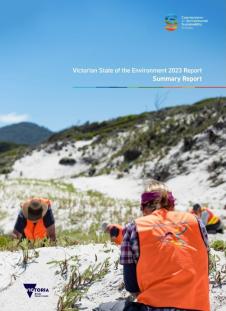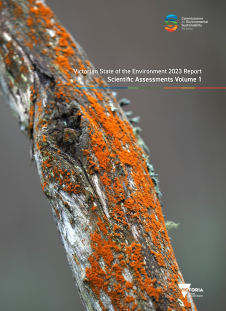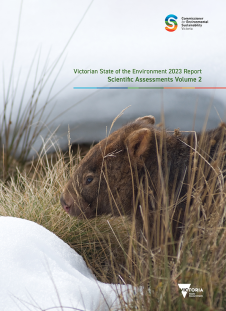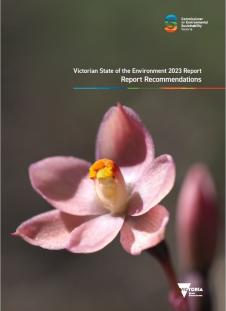Summary Report
The Summary Report begins with Part 1. This includes a summary of findings from the State of the Environment (SoE) 2023 Report, the indicator assessment dashboard and key findings.
In Part 1, key findings from each chapter of the scientific assessments are presented. You can find interpretations of these key findings under the key topics pages on this website.
Indicators
The indicator dashboard provides a synopsis of the assessments for the SoE 2023 Report indicator suite as a whole and a traffic-light representation of each indicator’s assessment by chapter including the:
- status of the indicator (good, fair, poor or unknown)
- overall trend (improving, stable, deteriorating, unclear)
- confidence in the data (high, moderate, low, insufficient)
- region covered by the indicator (statewide or a specific region)
- data source(s).
This report contains scientific assessments for 139 indicators. Of the 139 SoE 2023 indicators, 100 are the same as the SoE 2018 indicators, 24 indicators from SoE 2018 were modified, and 15 are new.
There are fewer indicators in this Report than the 170 indicators assessed in the SoE 2018 Report. This is because the SoE 2023 Report does not report on marine and coastal environments. Victoria’s Marine and Coastal Act 2018 requires a standalone, Victorian State of the Marine and Coastal Environment Report be prepared every 5 years with the first report due in 2024.
Recommendations
Part 1 also includes 15 recommendations that are informed by the analyses presented in Part 2 of the Summary Report and the Scientific Assessments. The recommendations are intended to support environmental improvement over the next decade and beyond. Although most do not specify delivery timelines, except where noted, it is anticipated they would be fully implemented by 2033, with clear progress evident within 5 years, recognising that the next SoE Report is due in 2028.
The recommendations:
- prioritise actions that improve multiple environmental outcomes
- focus on improving the evidence base to deliver key policy and legislative actions and targets
- are informed by the findings of other respected reports
- identify actions to achieve ecologically sustainable development and United Nations (UN) Sustainable Development Goals (SDG) targets by 2030
- support the development of a system for environmental-economic accounting for Victoria.
The CES Act requires the Victorian Government to respond to all the SoE recommendations within 12 months of the report being tabled in the Parliament of Victoria.
Space and spatial analysis
Part 2A contains an analysis of the application of space and spatial technologies for better understanding of, and responses to, biodiversity decline and other environmental challenges.
International frameworks
Summary Report Part 2B presents applications of 2 international frameworks to advance future SoE reporting:
-
the United Nations (UN) Sustainable Development Goals (SDGs)
-
the UN System of Environmental Economic Accounting (SEEA).
Appendices
There are 5 appendices in the Summary Report.
Appendix A includes more detail on spatial technologies and the opportunities they present to improve biodiversity and forests, mitigate climate change and improve air monitoring in Victoria.
Appendix B is a comprehensive assessment of progress on selected UN SDG targets.
Appendix C compares SoE 2018 and SoE 2023 indicator suites. It explains the modifications to the SoE 2018 indicators, which enabled:
-
a calibrated level of focus for assessing new and emerging environmental pressures
-
assessment of newly available data
-
greater alignment of indicator measures with policy targets to evaluate efficacy for improving environmental outcomes.
Appendix D is a compilation of the full indicator assessment summary tables by chapter.
Appendix E contains the reference list for the Summary Report.
Scientific Assessments
Scientific Assessments has been divided into 2 volumes for this Report. The detailed scientific assessments for each of the 139 SoE 2023 indicators are split across 10 chapters over the 2 volumes.
The following elements are presented in detail for each:
-
summary and analysis of the key findings
-
an overview of progress made by the Victorian Government against the SoE 2018 recommendation(s)
-
background information, including relevant policy and legislative settings
-
scientific assessments of the related indicators.
The scientific assessments rely on publicly available scientific data found in reports, journal articles, submissions to parliamentary and other government inquiries, citizen science projects and interviews.
The data are assessed and synthesised by the Commissioner for Environmental Sustainability (CES) science team which is followed by a peer review process by subject-area experts. Engagement through the Commissioner's Reference Group and Technical Advisory Groups is a feature of the approach to reporting.
The scientific assessments provide an evidence-based evaluation of Victoria’s environmental health and progress on environmental sustainability, expressed through the 139 indicators.
Each indicator’s scientific assessment includes an indicator assessment report card that presents:
-
the indicator’s 2023 and 2018 traffic-light summary
-
the region covered by the indicator (statewide or a specific region(s))
-
the measures used to evaluate the status and trend
-
the data source(s)
-
the reason for assessing the indicator
-
the criteria used for determining the status of each indicator
-
rationale and summary of the indicator assessment.
Each indicator’s scientific assessment also includes:
-
a summary of the 2018 assessment
-
the critical data used for the 2023 assessment.
Volume 1
This volume contains the following chapters:
-
Cultural landscape health and management
-
Climate change
-
Climate change impacts
-
Climate change mitigation
-
Climate change adaptation
-
-
Air
-
Biodiversity
-
Land.
Volume 2
This volume contains the following chapters:
-
Forests
-
Fire
-
Inland waters
- Water quality
-
Water resources
-
Energy
-
Waste and resource recovery.






